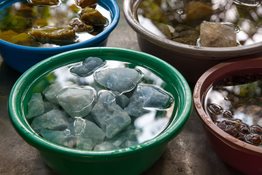Diamonds may be a girl’s best friend in some countries, but in Sri Lanka, it’s all about the sapphires...

Since ancient times, Sri Lanka has been the world’s go-to destination for precious gems; particularly the enigmatic and symbolic sapphires that are one the island nation’s best known calling cards. Although we associate this hard gemstone, mined in gravel riverbeds, with the intense blue that reflects the ocean waters around Sri Lanka, sapphires actually come in a wide range of colors, all well represented in the gem shops along Colombo Road - the Sri Lankan equivalent of New York’s 49th Street. Here you can find yellow, violet, dark green, and pink sapphires, as well s the very rare and highly prized pink/orange padparadscha sapphires. But the commonest colors are the light blue, or cornflower sapphires and the intense clear blue of royal sapphires.
Sapphires have been intricately linked with royalty since biblical times. The star-sapphire was associated in the ancient world with the goddess of love, Aphrodite, who gave Helen of Troy a large sapphire, said secret of her irresistible allure that “…launched a thousand ships.” Sapphires are also linked to the god Apollo, the patron of the Oracle of Delphi; sapphires were cherished as a powerful talisman for channeling truth, sincerity, and wisdom. But it is the biblical King Solomon, builder of the famous Temple of Jerusalem, who is most closely associated with sapphires according to each of the three Abrahamic religions. Biblical scholars believe that the famous “seal of Solomon” was, in fact, a large six-pointed sapphire, and it is possibly from this jewel that the iconic six-sided “star of David” came to be the symbol of the Jewish faith. Solomon’s sapphire gave him wisdom and power, and he wooed the beautiful Queen of Sheba with gifts of the precious gemstones.
From Solomon, the close royal association with sapphires continued in an unbroken line to modern times. In the Middle Ages, sapphires represented heaven and the Christian promise of salvation. The Holy Roman Emperor Charlemagne wore a sacred amulet with splinter of the True Cross secured between two large sapphires, which was buried with him, but exhumed by his descendants and passed through the line of the Kings of France to Empress Josephine, who wore it at her coronation in 1804. Rudolf II, the Austrian emperor, who spent much of his reign patronizing alchemists seeking the secret of turning base metal into gold, collected sapphires. The largest of these sits on top of the heavy imperial crown of Austria, symbolizing the preeminence of God above his anointed rulers. Britain’s kings and queens are crowned with the Imperial State Crown, which sports four flawless sapphires, including the 104-carat Stuart sapphire, which comes from Sri Lanka. The largest blue star sapphire in the history of the gemstone was found in Sri Lanka in 2016, weighing an incredible 1,404 carats.
Shopping for sapphires is a delightful experience in Sri Lanka’s bustling gemstone markets of Ratnapura (the City of Gems) and Kandy, where gemstones can be far more affordable than at home. Check with your local guide or host for a list of Sri Lankan National Gem and Jewelry Authority-approved stores to be sure that the bargain sapphire you buy is of the quality you expect.
Alexander + Roberts’s carefully curated itineraries to the Far East are filled with hidden gems of culture, history, and natural wonders. Speak to our experienced reservation agents about itineraries such as
The Captivating Isle of Sri Lanka, which includes visits to 5 UNESCO World Heritage Sites.